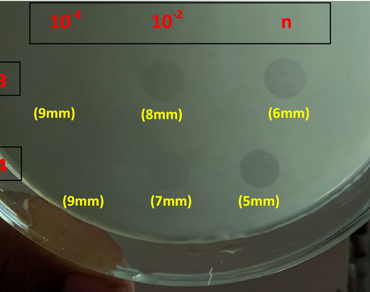Lytic bacteriophages in preventing the bacterial blight of pomegranate caused by Xanthomonas axonopodis pv. punicae
Karn Monika, Sharma Satish K., Handa Anil, Sharma Anju, Sharma Sanjeev, Sharma Umender
Research Articles | Published: 09 August, 2022
First Page: 643
Last Page: 650
Views: 3616
Keywords: Bacterial blight, Xanthomonas axonopodis , Pomegranate, Bacteriophages, Treatment
Abstract
The bacterial blight of pomegranate (Xanthomonas axonopodis pv. punicae) has become a serious problem in major pomegranate growing areas of India leading to complete destruction of the pomegranate orchards causing extensive losses in terms of quantity and quality of fruits produced. Bacteriophages, being specific to bacteria are thought to offer a viable option for controlling plant diseases. Bacteriophages were evaluated in vitro and potted plants against Xanthomonas axonopodis pv. punicae (Xap). Bacteriophages isolated from soil of infected pomegranate orchards at village Dharampur, Solan (HP) produced strong lytic zones through in spot assay in agar plates. Liquid cultures of X. axonopodis treated with bacteriophages individually or in combination showed bacterial lysis thereby killing of bacterial cells. In planta, phage mixture reduced the severity of bacterial blight when treated with formulated phages in skimmed milk simultaneously enhancing plant growth thereby suggesting the potential use of phages against Xap for managing bacterial blight disease of pomegranate.

References
Ackermann HW (2007) 5500 phages examined in the electron microscope. Arch Virol 152:227–243. https://doi.org/10.1007/s00705-006-0849-1
Ackermann HW (2009) Basic phage electron microscopy. In: Martha RJC and Andrew MK (eds) Bacteriophages: Methods and Protocols, Volume 1: Isolation, Characterization, and Interactions, Humana Press https://doi.org/10.1007/978-1-60327-164-6
Ackermann HW (2012) Bacteriophage electron microscopy. In: Advances in Virus Research vol. 82, Elsevier ISSN 0065–3527, https://doi.org/10.1016/B978-0-12-394621-8.00017-0
Ackermann HW (2001) Frequency of morphological phage descriptions in the year 2000. Arch Virol 146:843–857
Balogh B, Jones JB, Momol T, Olson SM, Obradovic A, King P, Jackson LE (2002) Efficacy of bacteriophage formulation for control of bacterial spot on tomato. Phytopathol 92:56
Bergamin F, Kimati H (1981) Estudos sobre um bacteriofago isolado de Xanthomonas campestris. II. Seu emprego no controle de X. campestris e X. vesicatoria. Summa Phytopathol 7:35–43
Chae J-C, Hung NB, Yu SM, Lee HK, Lee YH (2014) Diversity of bacteriophages infecting Xanthomonas oryzae pv. oryzae in paddy fields and its potential to control bacterial leaf blight of rice. J Microbiol Biotechnol 24:740–747
Civerolo EL, Keil HL (1969) Inhibition of bacterial spot of peach foliage by Xanthomonas pruni bacteriophage. Phytopathol 59:1966–1967
Cooksey DA (1990) Genetics of bactericide resistance in plant pathogenic bacteria. Annu Rev Phytopathol 28:201–219
da Silva JAT, Rana TS, Narzary D, Verma N, Meshram DT, Ranade SA (2013) Pomegranate biology and biotechnology: a review. Sci Hortic 160:85–107. https://doi.org/10.1016/j.scienta.2013.05.017.
El-Shibiny A, El-Sahhar S, Adel M (2017) Phage applications for improving food safety and infection control in Egypt. J Appl Microbiol 123(2):556–567
Flaherty JE, Jones JB, Harbaugh BK, Somodi GC, Jackson LE (2000) Control of bacterial spot on tomato in the greenhouse and field with H-mutant bacteriophages. Hortic Sci 35:882–884
Gašić K, Ivanović MM, Ignjatov M, Calić A, Obradović A (2011) Isolation and characterization of Xanthomonas euvesicatoria bacteriophages. J Plant Pathol 2:415–423. https://doi.org/10.4454/jpp.v93i2.1197
Gent DH, Schwartz HF (2005) Management of Xanthomonas leaf blight of onion with a plant activator, biological control agents, and copper bactericides. Plant Dis 89:631–639. https://doi.org/10.1094/PD-89-0631
Ghildiyal J. 2016. Studies on Variability and Management of Bacterial Blight [Xanthomonas axonopodis pv. punicae (Hingorani and Singh) Vauterin et al.] in Pomegranate. M.Sc. Thesis. Department of Plant Pathology. Dr YS Parmar University of Horticulture and Forestry. Solan. 1–3p.
Haq IU, Chaudhry WN, Andleeb S, Qadri I (2012) Isolation and partial characterization of a virulent bacteriophage IHQ1 specific for Aeromonas punctata from stream water. Microb Ecol 63:954–963
Harshitha KN, Manoranjitham SK, Somasundaram E, Rajendran L, Karthikeyan G (2018) Characterization of Xanthomonas axonopodis pv. punicae (Hingorani and Singh) Vauterin et al. and isolation of Xap specific bacteriophage. Madras Agric J 105:210-214
Hingorani MK, Mehta PP (1952) Bacterial leaf spot of pomegranate. Indian Phytopathol 5:55–56
Hingorani MK, Singh NJ (1960) Xanthomonas punicae sp. nov. on Púnica granatum L. Indian J Agric Sci 29:45–48
Jagdale S, Ahiwale S, Gajbhiye M, Kapadins B (2019) Green approach to phytopathogen: characterization of lytic bacteriophages of Pseudomonas sp., an etiology of the bacterial blight of pomegranate. Microbiol Res 228:126300.
Lokesh R (2008) Studies of the toxin produced by Xanthomonas axonopodis pv. punicae and the management of bacterial blight of pomegranate. M.Sc. Thesis. Department of Plant Pathology. University of Agricultural Sciences. Bangalore. 93–96p.
Mathur MD, Vidhani S, Mehndiratta PL, Bhalla P, Reddy BSN (2003) Bacteriophage therapy: an alternative to conventional antibiotics. J Assoc Physicians India 51:593–596
McKinney HH (1923) Influence of soil temperature and moisture on infection of wheat seedlings by Helminthosporium sativum. J Agric Res 26:195–217
McManus PS, Stockwell VO, Sundin GW, Jones AL (2002) Antibiotic use in plant agriculture. Annu Rev Phytopathol 40:443–465. https://doi.org/10.1146/annurev.phyto.40.120301.093927
Singh D, Singh RK (2004) Processed products of pomegranate. Nat Prod Rad 3:66–68
Sulakvelidze A, Alavidze Z, Morris JG (2001) Bacteriophage therapy. antimicrob agents. Chemotherapy 45:649–659. https://doi.org/10.1128/AAC.45.3.649-659.2001
Tewfike TA, Desoky SM (2015) Biocontrol of Xanthomonas axonopodis causing bacterial spot by application of formulated phage. Ann Agric Sci 53:615–624
Author Information
Department of Plant Pathology, Dr. YS Parmar University of Horticulture and Forestry, Solan, India